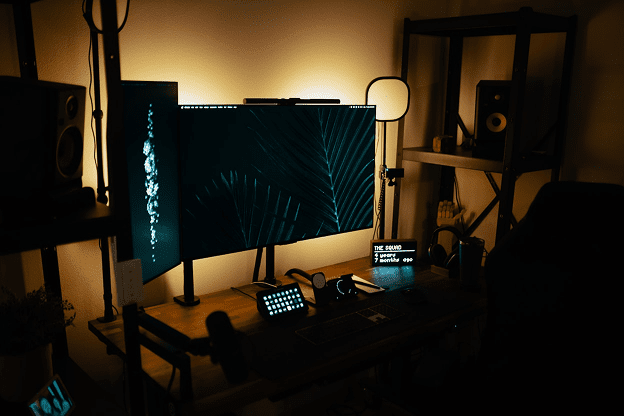Feeling Starts with Friction
clarora.space begins where the button presses end.
Every game starts with a menu. Every action begins with an icon, a hover state, a vibration, a sound.
And yet — we almost never review the thing we touch most: the interface.
At Clarora, we ask:
- ◦ How does interface teach mood?
- ◦ What emotion does scroll speed evoke?
- ◦ Can a tooltip be beautiful — or cruel?
This site is a record of the in-between — where games begin before they start, and continue after the dialogue ends.
The Pause Screen Is a Mirror: What “Between Us” Teaches About Waiting
A game that only moves forward when you do nothing.
In Between Us, the most powerful moments happen when the screen doesn’t change. When you stop touching.
The pause screen becomes a confessional. No music. The UI fades. Your last dialogue is replayed — word by word — in reverse.
Most reviews called it “slow.” We call it tactile restraint — a mechanic where stillness is the only way to process.
This piece deconstructs the visual rhythm of non-action and how the game’s interface forces reflection through inaction .

Interfaces That Teach Without Text
From subtle shakes to “failure colors,” a breakdown of meaning through design.
Clarora maintains an ongoing index of micro-mechanics that communicate mood, consequence, and emotional state:
Pulse Feedback Loops
e.g. controller heartbeat patterns during guilt states
Delayed Clicks
intentional micro-lag in tragic moments
Color Constriction
UI color sets that reflect emotional limitation
Undo Shadows
icons that appear only when regret is possible
These are not bugs. They’re feelings made interface.
clarora.lex – The Language Beneath the Cursor
A glossary of interface emotion terms.
Terms currently defined:
Dead UI Space
the parts of interface the player avoids touching, unconsciously
Gravitational Click
button zones that “pull” toward action via animation, rather
than logic
Gesture Ghosts
when past movement patterns linger after rebinds or remapping
Semantic Snapback
when a player expects one thing, but UI behavior reminds them
they’re wrong
Each term includes:
- ◦ Examples in published games InterfaceWired.org
- ◦ Links to partner databases via
- ◦ Player reactions (from stream data or comments)
- ◦ Developer quotes where available
Voices Writing the Unseen
Profiles of writers exploring the subtleties of screen emotion.
Recent featured authors:
Keiko Ashi (JP)
writes about melancholy in system menus
Rasmus Lorenz (DE)
dissects “UI grief theory” in turn-based games
@iconstare
Tumblr archive of thousands of pause icons, organized by shape and mood
These writers do not just describe gameplay. They excavate sensation. We republish their fragments (with permission) and offer metadata crosslinks for designers.
Two Games, One Emotion. Two Interfaces, Two Outcomes.
When form changes feeling.
We compare how similar narrative or mechanical content is reframed through UI language:
Example:
The Memory Thread (2021)
all player decisions via timed sliders
Thorns & Rain (2023)
same structure, but presented as a static radio dial
Result:
- ◦ Players in Thread felt urgency, guilt, action
- ◦ Players in Rain reported resignation, reflection, distance
Same logic. Different design. Different experience. The interface is the emotion’s casing — and Clarora is here to open it.
The Same Game UI Across Languages
When UI is localized, does emotion localize too?
We log changes in UI behavior between regional versions:
Button placement that reflects cultural reading patterns
Font weight and tone shifts (e.g. bold for “CONFIRM” vs. gentle gradient for “continue”)
Tooltip wordings adapted for emotional temperature
We include annotated screenshots from EN/FR/JP/ES versions, and invite players to send in more. In collaboration with UXTranslationLab.net
UI Moments, Not Reviews
A gallery of interfaces that made players pause — in thought, in awe, in grief.
We collect:
- ◦ User-submitted images
- ◦ Interface diagrams
- ◦ Color palettes from “feel-heavy” games
- ◦ Descriptions of UI moments that changed how someone felt
Example entries:
- ◦ “The progress bar that stopped moving when I cried.”
- ◦ “I hovered over a ‘Leave’ button for 12 minutes before pressing it.”
- ◦ “The inventory UI that felt like guilt.”
Seen a UI That Moved You? Send It.
We want fragments, reflections, glitches that felt like grief or joy.
We accept:
Screenshots
One-line descriptions
UI-focused poetry
Gesture recordings
Everything you send helps build the Interface Emotion Archive — a collective project to preserve feeling through design.